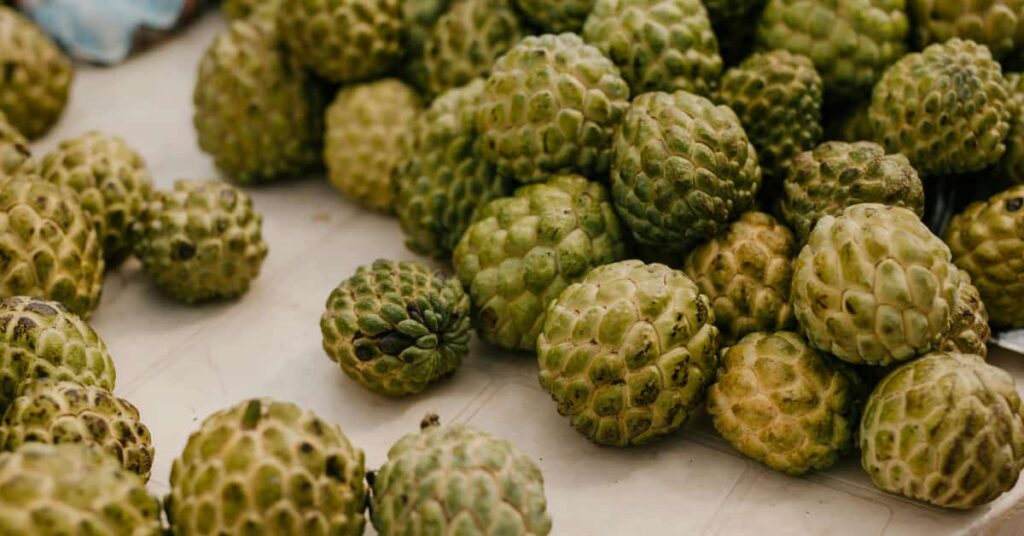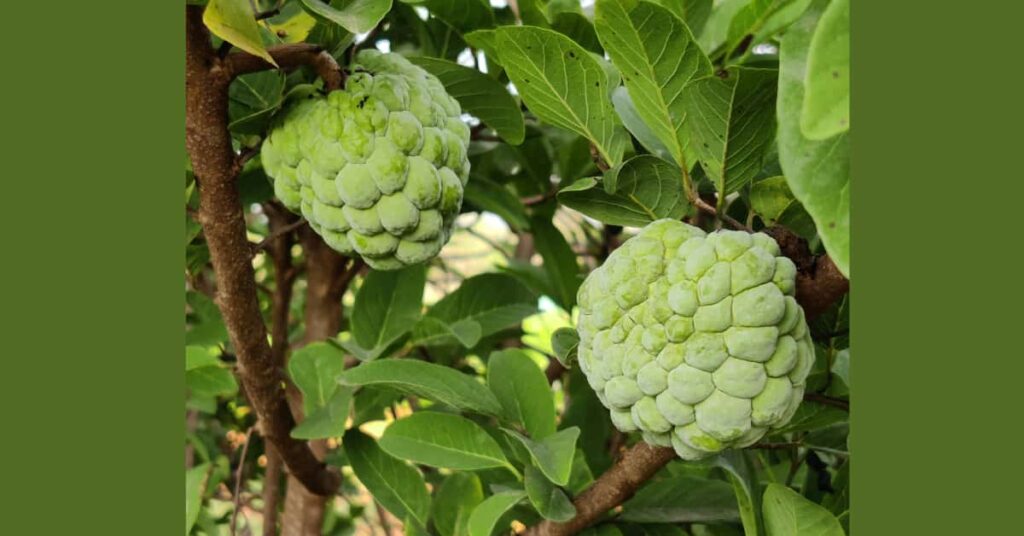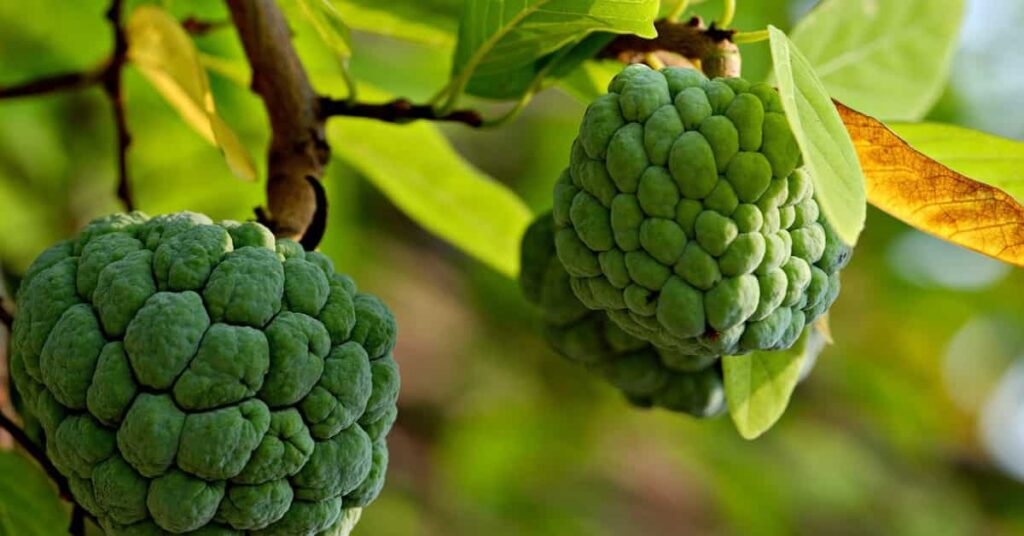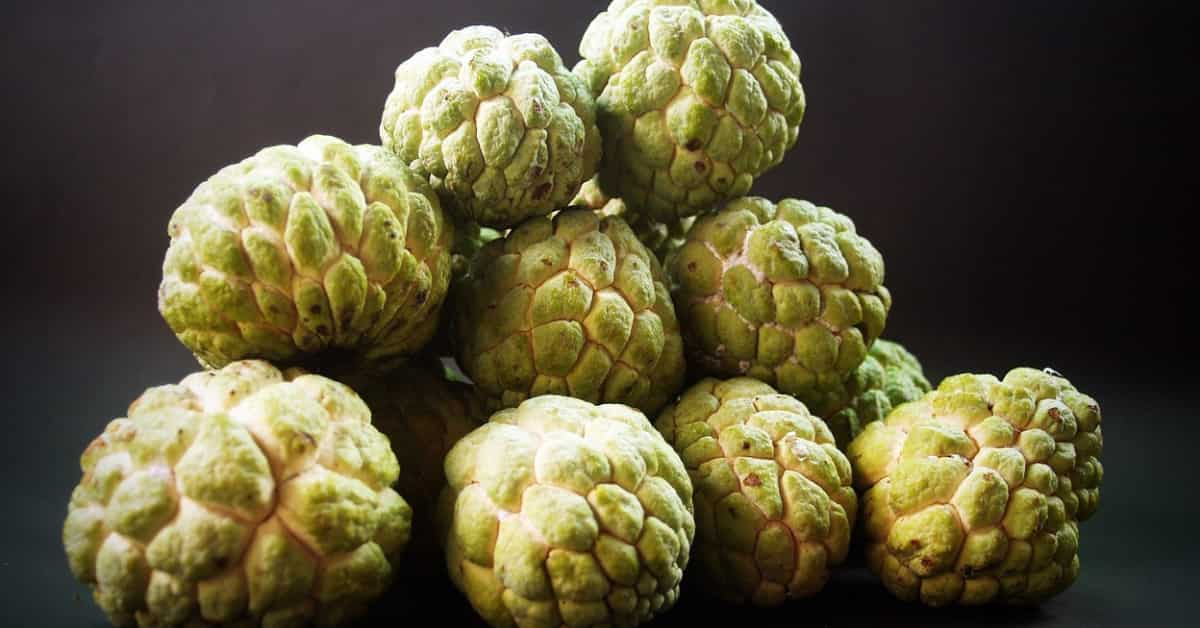Table of Contents
Introduction
Custard apple, also known as cherimoya, is a mouthwatering, nutritious fruit with green, fuzzy skin and creamy, delicious flesh, featuring a special flavor. The fruit is derived from the Andes Mountains of South America. It is very rich in fiber, minerals, & vitamins, supports Immunity, reduces inflammation, and encourages eye and heart health. It is a precious source of fiber, vitamins B6 and C, Potassium, and antioxidants. You may enjoy custard apples in diverse ways. Like any other fruit, you may eat it fresh or use it in smoothies, yogurt, ice cream, pies, and other desserts.
Custard apple is a delicious & nutritious fruit you may enjoy as part of a balanced diet. It’s a good source of necessary nutrients and may offer several health advantages. Nevertheless, the seeds and black skin of custard apples include annonacin, a neurotoxin that can be dangerous if ingested in large amounts. Just remember to release the seeds and skin before eating it. Let’s understand more about custard apples’ health advantages and nutritional value.

Custard apple(cherimoya)
The custard apple tree stands vertically with a 10- to 15-inch diameter. The tree is about 15 to 35 feet tall. Its leaves have a nasty smell and are shed from time to time. It even has fragrant, slender, hanging flowers that don’t fully open. The flowers are pale golden, with a purple or dark red spot inside, and light green on the outside.
They are green, with white flesh that has a custard-like texture. The fruit has a nearly acidic taste and includes dark-brown seeds. Its distinctive flavor is said to be a combination of pineapple and strawberry.
There are two main kinds of custard apples grown in the Pacific region — the soursop (Annona muricata) and sweetsop (Annona squamosa).
Soursop custard apples (cherimoya) are dark green, oblong, medium-sized, and have glossy spines that twist slightly.
The sweetsop is a shorter type of custard apple without spines.
Cherimoya are thought to have developed in the West Indies and to have been brought to southern Mexico via Central America. For a long time, the fruit has grown in places that stretch as far as Peru and Brazil. They were introduced into tropical regions of Africa around the seventeenth century, where they were grown as dooryard fruit trees in South Africa. The fruit tree is also produced or grows wild in areas around India. It’s present in the Philippines and other parts of Southeast Asia. Today, though, it’s more familiar in Bermuda, the Bahamas, and southern Florida.

Custard apple nutrition
A Cherimoya is a nutrient-dense fruit, with a 105-gram serving providing around 101 calories, 2.1 grams of protein, & 23 grams of carbohydrates. It is an important source of Vitamin C (around 21% of the daily value) and Vitamin B6 (around 17% of the DV), and is a valuable source of Potassium and fiber. Additional nutrients include magnesium, calcium, iron, and various B vitamins.
Nutrient Amount (per 100g)
Calories 101 kcal
Carbohydrates 25 g
Protein 1.7 g
Fat 0.6 g
Fiber 2.4 g
Vitamin C 19 mg
Vitamin B6 0.22 mg
Potassium 382 mg
Iron 0.71 mg
Magnesium 18 mg

Properties Of Custard Apple
They offer many benefits, making them among the most nutritious fruits to include in the diet.
- High in antioxidants: The antioxidants present in this fruit fight free radicals, lowering oxidative stress.
- Rich in fibre: It has a high fibre content, which allows for improved digestion and feeds the good bacteria in the gut.
- Plentiful in vitamin B6: Vitamin B6 present in this fruit recreates a vital role in the creation of neurotransmitters, which supports regulate mood.
- Loaded with carotenoids: It also supports good eye health as it is packed with lutein, a carotenoid antioxidant.
These belongings make custard apple a positively valuable addition to the diet.
Custard apple tree
A custard apple tree is a small, fast-growing, semi-evergreen tree in the Annonaceae family that can also be cultivated as a plant. It is understood for its sweet, creamy fruit and can be grown in a big pot or outdoors in frost-free climates. A successful harvest needs full sun to partial shade, well-drained soil, and frequent watering.
Growing conditions
- Sunlight: Full sun to partial shade.
- Soil: Well-drained, fertile soil wealthy in organic matter, ideally with a pH between 6 & 8.
- Water: Regular watering is needed, but bypass overwatering to prevent root rot.
- Climate: Best in frost-free areas. It can tolerate light night frosts down to -2 °C (28°F), but not waterlogging.
Cultivation
- From seed: Can be raised from seeds, which may grow in 10-12 days after soaking.
- Grafting: Another standard propagation process.
- Pots: Can be grown in pots with a sound drainage system, starting with a small pot and moving to a 12-19-inch pot as it grows.

Custard Apple Benefits
This fruit is not only a joy to the taste buds but always a powerhouse of essential nutrients. Let’s dive into the remarkable advantages of Cherimoya & understand why they should be part of a regular diet.
1. Loaded with Energy
It is an amazing source of energy, thanks to its high carbohydrate content. Consuming this fruit may provide an instant energy boost, making it an ideal meal for athletes or anyone who requires a quick pick-me-up during the day. The natural sugars in Cherimoya provide sustained energy, keeping you active and alert.
2. Controls Diabetes
Despite its sweetness, Cherimoya may be beneficial for individuals with Diabetes. As it has a low glycemic index, it loosen sugars slowly into the bloodstream, which can prevent sudden spikes in blood sugar levels. Additionally, the fibre content allows control of blood sugar by slowing the absorption of glucose.
3.Treats Skin Infections
The anti-inflammatory & antimicrobial properties of Cherimoya make it effective in treating various skin infections. Applying its pulp topically may soothe irritated skin, reduce redness, and promote healing. It’s beneficial for treating acne, boils, and other bacterial skin issues.
4. Improves Heart Function
Custard apple is very rich in Potassium & magnesium, two minerals crucial for heart health. Potassium allows for the regulation of blood pressure by balancing sodium levels, while magnesium helps maintain a regular heartbeat and prevents arrhythmias. Regular consumption of Cherimoya may contribute to better cardiovascular health.
5. Reduces Risk of Cancer
Custard apple includes antioxidants like flavonoids, which allows in neutralizing the harmful free radicals in the body. These free radicals may affect oxidative stress, leading to cellular harm & increasing the risk of cancer. By lowering oxidative stress, custard apple reduces the risk of developing various cancers.
6. Good For Eye Health
Vitamins A and C present in custard apple are crucial for maintaining good eye health. Vitamin A helps improve vision and prevent age-related macular degeneration, while vitamin C safeguards the eyes from oxidative harm. Including custard apple in the diet can help maintain healthy vision and prevent eye disorders.
7. Enhances Brain Activity and Function
The high levels of vitamin B in custard apple, mainly vitamin B6, play a vital role in brain health. Vitamin B6 is occupied in the creation of neurotransmitters, such as serotonin & dopamine, which regulate mood and cognitive function. Consuming custard apples can enhance brain activity, improve mood, and lower the risk of neurological disorders.
8. Promotes Good Digestion
Custard apples are very rich in fiber, that helps regulate bowel movements, prevent constipation, and promote the growth of beneficial gut bacteria. This, in turn, promotes better nutrient absorption & overall digestive health.
9. Boost Immunity
The high vitamin C content in custard apple strengthens the immune system by increasing the creation of white blood cells, that are essential for fighting infections. Regular consumption of these fruits lowers the frequency and severity of common illnesses, for example, colds and flu.
10. Improves Bone Health
Cherimoya is a good source of calcium & magnesium, both important for maintaining bone health. Calcium is important for maintaining bone density & strength, while magnesium helps with calcium absorption. Including custard apple in the diet can help prevent osteoporosis and maintain healthy bones.
11. Reduces Oxidative Stress
The antioxidants present in custard apple, for example, vitamin C, flavonoids, & polyphenols, help in lowering oxidative stress. Oxidative stress may lead to chronic diseases like heart disease, cancer, and Diabetes. By neutralizing free radicals, custard apple allows in protecting the body from these conditions.
12. Aids in Wound Healing
Custard apples also have medicinal properties. An ample amount of vitamin C promotes collagen production, which is essential for wound healing. In addition, the fruit’s antibacterial properties help prevent wound infections, thereby enabling faster, safer healing.
How to Eat
When choosing the right custard apple to eat, select one that’s light green or yellowish-green, with an expanded, scale-like skin. A ripe custard apple is lighter, with softer skin, while an overripe one has a darker skin color and more problematic skin. If this fruit is not ripe enough, consider ripening it in a dark place.
Before eating the custard apple, make sure you wash it well. Then cut the fruit into quarters & serve, or peel the flesh and remove the seeds, then serve. You can also blend or strain custard apples, depending on how you want to consume them. You can eat custard apples fresh or make various drinks with them.
You can also have custard apples directly by scooping the flesh from the skin, or serve them with cream and a sprinkle of sugar. Blending it lets you use it to make a sauce for cakes & pudding.
Custard apple taste
A custard apple tastes sweet and creamy, with a texture similar to custard, sometimes described as a mix of pineapple, vanilla, and banana. The flavor is rich and fragrant, and some varieties can have notes of other tropical fruits or a taste similar to sweet condensed milk.
Conclusion
The Custard Apple (Sitaphal), often hailed as a “Queen of Fruits” in its native tropical regions, is far more than just a delicious seasonal treat. Its creamy, sweet flesh offers a rich tapestry of essential nutrients, standing out particularly for its high Vitamin C content for immune support, Vitamin B6 for neurological health, and Potassium for cardiovascular well-being. Beyond its appealing flavor, its significant dietary fiber content aids digestion, while a diverse array of antioxidants combats oxidative stress throughout the body. Thus, incorporating this unique and wholesome fruit into one’s diet provides a delightful way to bolster overall health, offering a natural powerhouse of vitamins, minerals, and protective compounds.




